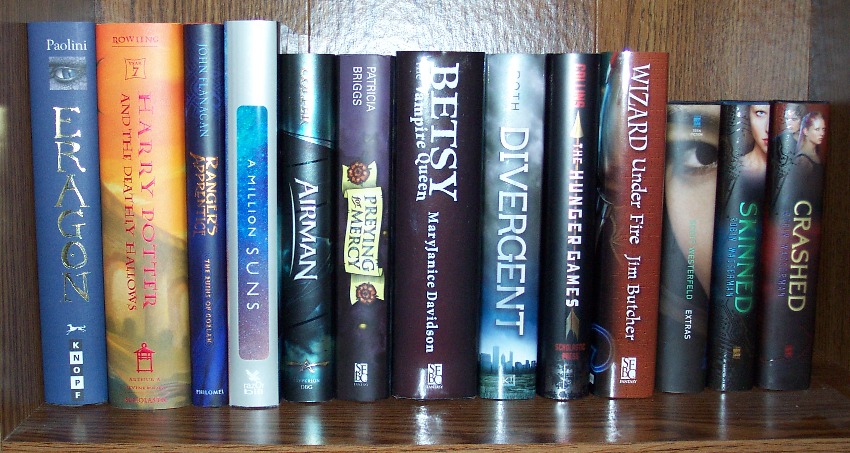Generally I call all regular paperbacks trade paperbacks, but I'm likely mistaken. Anyway, there are several differences: spaces between lines in the book, paper quality, how the pages are glued to the cover, price, and size. I'm going to talk about size of both paperbacks and hardbacks.
I'm more than a bit obsessive-compulsive about my books and how they're arranged on the shelves. Nothing makes me squirm more than seeing a series arranged right to left (3, 2, 1). After that is the series's book size and format (they have to all be hardback or all paperback, and heaven help me if the paperbacks are differently-sized) then where they are arranged in coordination with other books. I don't generally arrange by author or even genre, but rather what feels right to me, and sometimes that often changes on a whim (or a new book added to a series) and I spend a while rearranging my books.
It's like asking a crazy person how to fold a tinfoil hat: I know what I'm doing.
I've also had several problems with shelves. I had my entire Science Fiction Book Club editions of The Dresden Files sitting pretty on a small shelf until we dropped it in favor of buying from brick and mortar stores. This included a size change that caused my shelf to be too short for the latest Dresden Files book and I'd been forced to move the entire collection because of 1 inch of height.
I will be measuring the most standard book sizes by height and depth. Height is the obvious height of the book, whereas depth is how "deep" the book is resting on the shelf (it would be width if you were looking at the cover). I will not be measuring width as it sits on the shelf because that, of course, varies depending on the length of the book. Note that I am rounding to the nearest 4th of a percent, so I'm not saying things like 3/8ths of an inch. Measurements may also be inaccurate from some used paperback books I used to measure, as they were a little warped in the spine.
(I also apologize in advance for some of the books I have selected at random. I have made some poor choices in my life.)
I'm going to start with hardbacks.
 |
Ranger's Apprentice and Hunger Games are your two standard hardbacks. There are going to be all kinds of variations, and that's why I have several here for comparison. Young Wizards isn't too unusual of a hardback, as I've seen a couple that large. Maximum Ride is somewhere in between, and Skinned is a format I've heard referred to as a "Baby Hardback." I would have included these as a standard hardback but these were more common about 5 years ago (their paperback versions being the same exact size ratio) and have since then faded into obscurity, their paperback forms often being changed to a standard paperback. It likely had something to do with market appeal (the Uglies series by Scott Westerfield and the Gripping trilogy by Robin Wasserman both being good examples of this conversion.)
The size of Hunger Games I generally call Hardback Size #1 because it is the most common. It is the most likely size a book comes in these days and the size you will see on the shelves in bookstores. Hardback #1 measures 8 1/2 tall by 6 1/2 inches deep. It is also the size most book clubs use for their books.
The Ranger's Apprentice book size I call Hardback Size #2. HB #2 used to be more common in brick and mortar stores, though I've noticed it's been fading out in favor of HB #1. If a book is not HB #1, chances are it will be HB #2. Hardback #2 measures 8 1/2 tall by 6 deep.
As I mentioned, some hardbacks will be more random. Maximum Ride, I believe, has the height of HB #2 and the depth of HB #1
Here is an example of the three book sizes: Hardback #2, Hardback #1, and then Baby Hardbacks (note some Science Fiction Book Club omnibuses mixed in with HB #1 books from brick and mortar stores.)
 |
| "I've never heard of any of these authors," you say. |
Stay tuned next week for paperbacks.
No comments:
Post a Comment